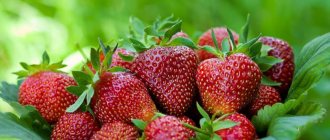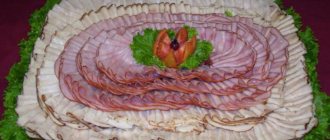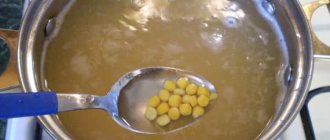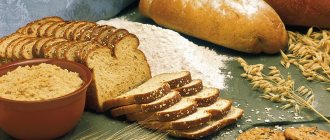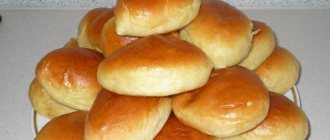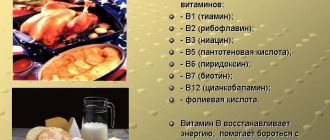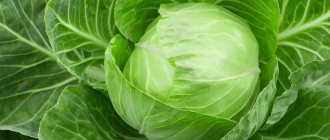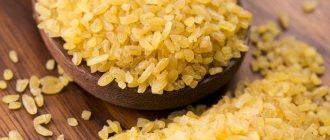The well-known saying “grows by leaps and bounds” is completely justified by the properties of this product.
The dough rises - the hostess rejoices. We are accustomed to airy baked goods and no longer even ask ourselves the question: is yeast dangerous for health?
Let's take a closer look at one of the most interesting ingredients - yeast.
Today you will learn all about them. History, whether they are dangerous to health, why they are useful, how to breed, store and much more.
The material turned out to be quite voluminous - I recommend using the navigation on the right to get an answer to a specific question that interests you. If you are interested in everything, then welcome to the world of yeast.
Food history and value
Yeast has been used in cooking for quite some time. This happened many centuries ago in distant Ancient Egypt. The Egyptians first learned to brew beer and much later bake yeast bread. For the modern world, the properties of yeast were discovered by the French microbiologist Pasteur (1857). 24 years later, the first yeast culture was developed in Denmark.
At the end of the 19th century, “bred” yeast began to be used in digestion. To date, more than 1.5 thousand varieties of these microorganisms have been cultivated. But for our diet we use only 4 of them:
- wine (plaque on grape bunches);
- dairy (fermented milk products with natural leaven);
- bakery (pastries);
- beer houses (“live” beer).
Calorie content of dry yeast – 75 Kcal/100 g.
Calorie content of live yeast – 119 Kcal/100 g.
Most often you come across baker's yeast, which is used all over the world as a leavening agent for dough.
How much yeast does the body need per day?
Yeast is prescribed as a useful remedy for many diseases. These are various infections, furunculosis, diabetes mellitus, skin diseases, gastrointestinal pathologies. In all these cases, the amount of the drug must be determined by the attending physician. For example, with low acidity, it is recommended to drink 100 ml of beer starter half an hour before meals for a month.
For preventive purposes, to enhance protein and vitamin nutrition, the following amount of yeast per day is recommended:
- dry – up to 25 g;
- pressed – up to 100 g;
- yeast paste – up to 50 g;
- drinking - up to 500 g.
Recommended reading: Benefits of rice flour
The benefits of drinking yeast were widely known during the war. With their help they saved Soviet people from hunger and disease and helped them survive. Yeast was made from wheat or rye flour: it was a highly nutritious and palatable drink.
What is yeast?
Before delving into what kind of yeast there are and what their main differences are, let’s first figure out what they are.
If anyone doesn’t know, yeast is a living organism that is a single-celled fungus. Their cells are ovoid and can only be seen under a microscope. 1 gram of yeast contains 20 billion cells, I will write in numbers - 20,000,000,000 so that you can appreciate the full scale.
Scientifically, the yeast we all use in baking is called Saccharomyces Cerevisiae , which loosely translates to “the mushroom that eats sugar.”
In simple words, it looks like this: yeast “eats” sugar and converts it into carbon dioxide, due to which the dough increases in size, swelling from the inside. In addition to gas, they also produce ethyl alcohol, which gives baked goods a characteristic yeast aroma and taste, and thanks to this we have the opportunity to drink alcoholic beverages such as wine, cognac, brandy, whiskey and many others, but this is a topic for another conversation.
You may have noticed that not every dough recipe contains sugar , in which case what does the yeast feed on and why does the dough grow?
The thing is that sugar, or rather sugars, are not just crystal-like granules that you add to tea. There are several varieties: sucrose, fructose, glucose, maltose. In short, sucrose is the granulated sugar we are used to, extracted from beets or cane, fructose and glucose are found in honey, molasses, fruits, and maltose is sugar that is present in sprouted grains of barley, rye and other grains, and most importantly for us - in wheat , from which flour is obtained.
It is precisely because the flour contains maltose that the yeast has something to eat without adding sugar. But adding sugar helps speed up the process.
This is interesting: fermentation is a natural process; so-called wild yeast is found in nature, which is found on the shells of many berries. Thanks to them, ripe grapes full of sugar can turn into wine without additional yeast.
What are the benefits of yeast?
The beneficial properties of baker's and brewer's yeast have been used by people in medicine since time immemorial. They contain a lot of value for the body: proteins with essential amino acids, carbohydrates and a whole range of enzymes and minerals. That is why this product, which is quite affordable compared to dietary supplements, is suitable for correcting metabolic disorders, problems with the immune system, the effects of stress, as well as hypovitaminosis.
The benefit of wine yeast for humans lies in its resistance to alcohol, fermentation of grape marc, and transformation of it into high-quality wine. In addition, their beneficial properties are revealed in improving blood circulation, strengthening the vascular network, and preventing cardiovascular diseases. Scientists have discovered the relationship between yeast and gastrointestinal microflora, in particular, a beneficial effect on the inflamed intestines.
In addition to the fact that yeast carries micronutrients, it also allows the synthesis of essential vitamins (B-group, C) inside the human body, and also strengthens the immune system by being a catalyst for the most important biochemical processes. Single-celled organisms lower blood sugar and provide many beneficial substances, including selenium, which has strong anti-cancer activity.
Attention! Scientists have discovered another beneficial property of yeast: taking it during times of nervous overload and stress improves the ability to concentrate. So those who are preparing for exams or competitions should also take the leap.
Harm and benefit
The topic of beneficial and dangerous properties of “domesticated” mushrooms is controversial. Even biologists cannot come to a general conclusion. While the debate between “naturopaths” and industrialists is ongoing, yeast-based delicacies are increasingly found on dinner tables from Japan to America. Which side to take is a personal matter.
Benefits of yeast
The benefits of any product are determined by its composition. Yeast contains:
- minerals (potassium, manganese, sodium, copper, calcium, iodine, iron, phosphorus, zinc, magnesium, molybdenum);
- vitamins (group B - B1, B2, B5, B9, D, E, P);
- cellulose;
- glucosidase;
- proteinase;
- peptidase;
- beneficial amino acids (10%).
Each type of yeast has its own unique composition, so they act differently. All types are classified as dietary protein products (protein content 66%). Yeast proteins are in no way inferior to those found in meat or fish. They are recommended to be included in a vegetarian diet to compensate for protein deficiency.
Dairy yeast is also a probiotic; it supports normal intestinal microflora. Amino acids are involved in the metabolic process and the functioning of important organs. Yeast also lowers cholesterol levels, helps with constipation and other gastrointestinal problems, is useful for anemia, and regulates blood pressure.
Yeast damage
An interesting fact: in documents from the times of Nazi Germany, the wording “if the Russians are not destroyed by war, yeast will do it” was discovered. Indeed, many of us feel some discomfort after eating yeast products. There are several factors for this:
- Death of the “native” microflora. Once in the digestive tract, yeast microorganisms begin to actively multiply. The process negatively affects the normal flora. As a result, disruption of the gastrointestinal tract, liver, and gallbladder.
- Decreased regeneration function. Nature has embedded a unique self-healing mechanism in the human body. If, for example, part of the liver is removed, it will be restored in a healthy body within a month. But provided that fermentation processes, which are caused by yeast, do not occur in the body.
This applies to live yeast . During the baking process, microorganisms are killed due to exposure to high temperatures. Therefore, rich bakery products are safe in this sense.
Beneficial features
For normal intestinal function, the presence of yeast is simply necessary. Therefore, doctors recommend consuming up to 7 g of yeast per day. This will provide the daily requirement. This is especially important in the following conditions:
- mental and physical overload;
- stress;
- dermatitis, acne;
- anemia;
- malnutrition;
- vitamin deficiency;
- metabolic disorders;
- burns;
- neuralgia;
- reduced immunity;
- chronic fatigue;
- diseases of the gastrointestinal tract;
- increased radioactive background.
The unique composition of yeast activates the digestion process, increases appetite, and normalizes metabolism. Microorganisms affect intestinal absorption. Yeast improves the absorption of many nutrients.
But again, do not forget that natural/live yeast in the dough dies during baking , since it is unstable at high temperatures. Therefore, baked goods cannot be considered a source of live yeast, which means they do not have any beneficial effect on the body.
What is brewer's yeast? Kinds
Yeast is used as a food additive, the product is formed during the fermentation process of malt, hops, barley and water. The product consists of yeast fungi that enhance the fermentation process.
The product is used in the production of beer, baked goods, and is also included in dietary supplements and cosmetics. In small concentrations it has a beneficial effect on the body.
The following types of product are in demand:
- Liquid (live) yeast is natural, the most useful, but has a short shelf life. Yeast is used for beer, kvass, culinary products, etc. The product is not used for dysbiosis, fungal diseases, candidiasis.
- Powder - products sold in pharmacies. Can be stored for a long time at room temperature. Before use, the product is diluted with water.
- Yeast tablets are an easy-to-use dietary supplement. The products are stored for a long time and are easily accepted, because... There is no need to dilute the product in water. The dosage is easily determined. Tablet products can be supplemented with vitamin and mineral complexes in order to increase benefits for humans.
the product is formed in the process of fermentation and fermentation of malt, hops, barley and water
Composition and release form
The food supplement has a rich chemical composition. Up to 40% of the product contains protein compounds, amino acids, enzymes, vitamin complexes, minerals, fatty acids, sorbents, etc. The product is available in tablets, capsules, powder, and natural form (bars). Tablets and capsules are enriched with silicon dioxide and can be produced with magnesium and other useful components.
Vitamins and microelements in brewer's yeast
The product contains the following vitamins:
- group B;
- D;
- R;
- E;
- N;
- folic acid, etc.
In the list of mineral components:
- phosphorus;
- zinc;
- iron;
- selenium;
- magnesium;
- calcium;
- sulfur;
- manganese;
- copper.
Nutritional value and calorie content of yeast
The calorie content of the product is low; yeast (per 100 g) contains about 75 kcal. The product has the following nutritional value per 100 g:
- protein compounds - 12.7 g;
- fats - 2.7 g.
There are no carbohydrates in the product.
Thanks to the biologically active components included in the product, the product has a positive effect on human health
pharmachologic effect
The pharmacological effects of the product are as follows:
- normalization of the digestive system;
- removal of toxic substances;
- improvement of metabolic processes in the body;
- immunostimulating effects;
- general strengthening effect;
- detoxification effects;
- neutralization of the effects of stress and overload;
- prevention of anemia;
- normalization of the cardiovascular system, etc.
Conditions of sale, storage and expiration date
The product is not a medicine and is sold in pharmacies without a prescription. Natural instant yeast can be stored for 2 days, dry active additives - for 1 month. Granular products retain their beneficial properties for up to 3 months without opening the package; when the box is opened, the contents of the package are used within 24 hours.
Brewer's yeast autolyzer in tablets has a shelf life of 1-2 years. Packages are stored in a dry place protected from sunlight at temperatures up to +25°C.
Contraindications for consuming yeast
Tremors are still a specific product that not everyone can use. Contraindications include some diagnoses:
- allergy to yeast-containing products;
- decreased kidney function;
- diseases of the endocrine system;
- dysbacteriosis;
- thrush;
- gout.
Abuse of yeast products is also dangerous for a healthy body. An excess of fungal microorganisms causes deterioration in the absorption of calcium and some other vitamins. Women prone to thrush should control their diet.
And for the third time: all of the above applies to the use of live yeast (unpasteurized/unfiltered beer, homemade fermented milk products, etc.) you don’t have to worry about baked goods.
Harm of compressed yeast
It's a shame, but this wonderful product also has contraindications. For example, women, before starting to use pressed yeast for food, should definitely consult a gynecologist, since their uncontrolled use can result in thrush. Harm from pressed yeast can also occur in cases of kidney disease, gout, dysbacteriosis and endocrine disorders. Naturally, if you are individually intolerant to the product, you should also refrain from using it.
Types of baker's yeast
Liquid yeast
Until 1825, yeast was sold in liquid form. At the moment, yeast in liquid form is used mainly in industrial production and authentic bakeries, where tradition is respected. Such yeast is practically never found on sale.
Pressed (fresh) yeast
The most popular type of yeast, which is found everywhere from markets to large supermarkets.
Depending on the manufacturer, the color can vary from white to light brown. It is usually sold in the form of small bricks weighing 100 grams.
The freshness of the product can be determined by its even color and structure. When broken off, the yeast should not spread - just crumble.
This type of yeast is the cheapest and most accessible. Before adding to the dough, the yeast needs to be revived in water, how to do this - read below.
When purchasing, pay attention to the production date, because this yeast does not last long.
Active dry yeast
Dry yeast is considered more modern. They are sold in the form of spherical granules, reminiscent of beads, packaged in bags.
They are not much more expensive than live ones, but are not so demanding on space and storage conditions. Similar to live ones, before adding them to the dough, they need to be “revived” by dissolving them in water.
Instant (high-speed) yeast
Usually sold packaged in 7-11 grams. The main difference from dry ones is that they can be added to flour immediately, in dry form.
Where is dry yeast used?
The main area of application for dry yeast is, of course, baking. With their help, you can prepare aromatic and airy butter dough, and from it - baked pies, buns, rolls, Easter cakes. Recipes with dry yeast are not at all inferior to those with pressed yeast.
At home, dry yeast produces delicious kvass. They are used to start the fermentation process when making wine. Dry yeast is a good remedy for treating problem skin. Masks based on them are among the most effective in cosmetology.
After opening the package, dry yeast reacts with air, gains moisture and loses its quality. To slow down a possible reaction after use, they should be stored in the refrigerator.
How to store?
Yeast is a living product and therefore requires special storage conditions . Compliance with them will determine how quickly the dough rises and whether it rises at all.
Live compressed yeast
Purchased yeast should be kept at a temperature of 0 to 4 degrees. At room temperature, compressed yeast retains its properties for no more than a day, in the refrigerator with a closed package - up to 4 weeks, with an open package - up to 2 weeks .
Pressed yeast can be preserved by crumbling it and mixing it with flour. Then let them dry by placing them on thick paper. After drying, place the yeast in a glass jar with a lid. Store the container in a dark place. Before next use, be sure to check their suitability.
Another way is to put the yeast in a glass container, pour vegetable oil over it and close tightly. Keep refrigerated.
Dry yeast
A whole closed package of dry yeast can be stored for 1.5 years. The main thing is that the place is dry and cool without sunlight. After opening the package, the properties of the yeast deteriorate.
The maximum period for using an open bag with microorganisms is 2 weeks. But some housewives manage to extend it to several months.
To preserve the yeast functionality, you need to pour it into a glass jar, close it securely and put it in the refrigerator. This storage method extended the “life” of microorganisms to six to eight months .
Dry instant yeast
Not demanding on storage conditions. They can last for a year in a sealed package and are good for baking. It is better to put the opened package in the refrigerator.
Instant yeast is convenient because it is packaged in 7-11g packs. and often one recipe requires a full pack.
Is it possible to freeze yeast and how to do it?
Many housewives mistakenly believe that the freezer will “kill” the yeast. On the contrary, it will help preserve them longer. This is the best way to store living microorganisms.
For a pressed product, the algorithm of actions is as follows:
- Remove the briquette from the paper.
- Cut it into manageable pieces, each of which is wrapped in foil.
- Place all portions in a bag, tie it securely and put it in the freezer.
In this form, live yeast can sit for six months and still be suitable for baking. You just need to defrost the piece in the refrigerator first. Of course, such yeast will need a little more time to rise. To speed up the process, they can be “fed” with sugar dissolved in warm water.
Active or instant dry yeast can also be stored in the freezer. This will extend their shelf life significantly.
But do not overuse this method of prolonging the life of yeast. There is no need to make large reserves for future use to save money. Stale yeast will make the baked goods heavy and rubbery.
Used in recipes:
Grandma's buns Brioche Cinnamon rolls Pancakes Homemade bread with cheese and herbs Filled donuts Grain buns
| Navigation: All recipes |
- Test on traffic rules The database contains 285 road signs of the Russian Federation approved by the rules of the road (SDA)
- Memory test It is prohibited to use paper and pen, telephone and camera!
- Flags of countries of the world Take a test on your knowledge of country flags, strengthen your knowledge of geography
- Determine your level of intelligence. Intelligence quotient (English: IQ) is a quantitative assessment of a person’s level of intelligence.
- Location of countries Take a test on your knowledge of continents and continents, strengthen your knowledge of geography
- Fortune Teller Test You have to concentrate and try to guess where the ace is hidden!
- Mega IQ test When performing the test, you cannot use paper, a calculator, a pen, a cheat sheet, the Internet, or tips from a friend.
- Test on geography and countries of the world Test on knowledge of the countries of the world by flags, location, area, rivers, mountains, seas, capitals, cities, population, currencies
- Test: Neighboring Countries The database contains detailed information about 199 countries of the world!
Free games online · Eng · CZ Hry · Games online for free · Icon on your Web · Visitors' book · RoboStav Copyright (c) 2020 by Topglobus.ru. All rights reserved!
How to breed yeast
We already know that there are three types of yeast:
- Pressed (live).
- Dry (active).
- Dry fast-acting.
Each of them is divorced in its own way.
Live pressed yeast
The technology for preparing live yeast is simple:
- Crumble the product into a ceramic or glass bowl, add 1/2 cup warm milk or water. No salt or sugar. The yeast should be completely dissolved. Make sure that the temperature of the liquid does not exceed 40 degrees, otherwise the microorganisms will die.
- Leave the diluted product for 20 minutes in a warm place.
- You can prepare butter dough. It is recommended to maintain the following proportion: 25 g of live yeast per 500 g of flour.
If live yeast has become airy , it can be rehabilitated by dissolving it in warm water with ½ teaspoon of granulated sugar. If after some time they bubble, their properties have returned. You can safely take up baking.
Dry active yeast
As a rule, manufacturers include instructions for breeding them. There is nothing complicated about this:
- Pour the required amount of warm liquid (no more than 40 degrees) - milk or water - into the bowl. The proportions are indicated in the recipe. The process should not turn into brewing; you need to “wake up” the yeast, and not destroy it.
- Add a few small spoons of granulated sugar to the liquid, stir until completely dissolved.
- Sprinkle dry yeast on top, and once the granules have swelled, stir. You should get a paste-like mass.
- If the kitchen is warm, you can simply cover the dishes with a bag. If it's cool, wrap the structure in a thick towel.
- If you did everything correctly, after 10 minutes the yeast will start to sparkle. You can knead the dough.
If the yeast “does not wake up” , it means either a low-quality product was obtained, or the cooking technology was violated. In any case, such a product is not suitable for baking .
Dry instant yeast
Instant yeast is known as fast or instant. Their properties justify the name.
Such yeast does not need to be diluted , which saves a lot of time.
Dry fast-acting yeast should be added to the flour immediately when kneading the dough and not wait for its activation.
Yeast for weight loss
Yeast starter can benefit those who want to lose weight. As you know, one of the causes of obesity is a violation of metabolic processes in the body. Yeast helps eliminate this problem, but physical activity and a balanced diet are also necessary to obtain beneficial results.
It is necessary to strictly follow the dosage regimen indicated on the package, and also not to get carried away with the drug in pursuit of a slim figure, otherwise the benefit can easily turn into harm. They are consumed in small portions and high-calorie foods are excluded from the diet.
Interchangeability
All baker's yeast is completely interchangeable . If the recipe calls for live yeast, you can easily replace it with dry or instant yeast. This will not negatively affect the dough in any way. But the fermentation time may change.
Also, when replacing one type of yeast with another, you must also recalculate the dosage.
Ratio of dry yeast to fresh
1 g dry yeast ~ 3 g fresh yeast
Ratio of instant yeast to fresh
1 g instant yeast ~ 6 g fresh
What is the difference between dry yeast and pressed yeast?
The next day, I asked my mother to show me the principles of working with fresh (pressed) yeast and bake bagels with yeast dough. And also take a second portion of dough and knead it with dry yeast. But from a different manufacturer, because... I didn’t like the result with dry yeast buns.
We took the same amount of milk and sugar, heated it to 33 degrees and added 21 grams of fresh (pressed) yeast to the first mug and 7 grams of dry yeast to the second.
The first observation was not long in coming: bubbles quickly began to appear and grow in the milk with fresh yeast. In the milk with dry yeast, bubbles also began to appear, but much more slowly.
We wanted to compare 2 bagels made from different dough batches and how they would rise and bake.
But we were unable to knead both doughs at the same time: the milk with fresh yeast began to rise so quickly in relation to the second container that it was necessary to knead the dough, while the milk with dry yeast only rose by half.
But the photo next to number 1 is milk with yeast, next to 2 is foam.
This is how we reached the first conclusion: fresh pressed yeast activates faster than dry yeast
. They can be used for the test in about 5-10 minutes.
The dry ones had to be left to rise much longer, about half an hour, but in the end they also rose well.
We cut out two absolutely identical pieces from the dough with fresh and dry yeast.
And they rolled 2 identical bagels. We left them to rise on the baking sheet to see if the dough would rise equally or not.
By clicking on this photo, you can draw a line to the right and left, seeing how much the bagel has grown after baking in the oven.
The bagels turned out airy and very tasty. The photo shows their porous structure inside.
But the dry yeast bagel tasted a little like yeast (or maybe I’m very sensitive to it, but that’s the fact).
We have experimentally verified that if you activate the yeast correctly, you can replace fresh (pressed) yeast with dry yeast in a recipe and vice versa
.
Moreover, in a ratio of 1: 3, i.e. if the recipe specifies the amount of fresh yeast in grams, dry yeast should be taken three times less
. I also tested this point experimentally, but this is the topic of another article. This ratio is explained by the method of obtaining dry yeast from fresh.
The use of yeast in home cosmetology
Knowledge about the health benefits and harms of yeast is used by people not only in nutrition or medicine, but also in cosmetology: both at home and on an industrial scale. Single-celled organisms contain especially many useful beauty vitamins responsible for the condition of the skin. Ascorbic acid is necessary for the construction of collagen, which provides the skin with elasticity and firmness. The beneficial properties of nicotinic acid, vitamin PP, lie in the regulation of tissue respiration and a beneficial effect on hematopoiesis.
Riboflavin, also known as vitamin B2, takes an active part in the formation of hemoglobin. Vitamin B12 ensures the maturation of red blood cells, erythrocytes, which contain hemoglobin. With a lack of beneficial properties of these two vitamins, the skin becomes pale and begins to peel. And together they take care of ensuring a beautiful complexion and a healthy, blooming appearance.
For facial skin
Yeast masks are easy to prepare and do not require expensive additives, yet they have an abundance of beneficial properties. Several recipes useful for different skin types:
- Normal. Grind 30 g of yeast with 2 tablespoons of boiled milk. Apply to your face, don’t forget your neck. After 15 minutes, rinse off
- Dry. Take 20 g of yeast, a teaspoon of honey, a tablespoon of wheat flour. Grind, adding warm boiled milk to the desired thickness. The procedure time is 20 minutes. Rinse off with warm water,
- Oily, porous. Dilute 20 g of yeast with a small amount of kefir with a minimum percentage of fat content - so that the result is the consistency of thick sour cream. Let it dry on the skin, then rinse off.
If suddenly the benefits of a yeast face mask seem doubtful, or cause burning or itching, it should be washed off immediately and soothe irritated skin with lotions made from chamomile or sage infusion.
For hair beauty
The benefits of yeast for hair are well known. They are used to make various cosmetics and detergents, including at home. To prepare masks, you can take both live and dry substrate. First, dissolve in a warm liquid medium (water, milk, kefir, herbal infusion), let it ferment for at least half an hour or an hour. During this time, all active elements will be in a state of combat readiness. There are various useful recipes, depending on the type of hair and the purpose of using the cosmetic product: to accelerate hair growth or simply strengthen it, make it healthier and nourish it.
For example, for dry hair, a yeast mask with kefir is used, the beneficial properties of which are unique in getting rid of dandruff, moisturizing, nourishing and accelerating growth. To do this, you need to heat a cup of lactic acid drink, add a tablespoon of dry yeast. Place in a warm place, after an hour apply to hair and scalp. Leave for half an hour and rinse by rinsing your hair with water and vinegar.
